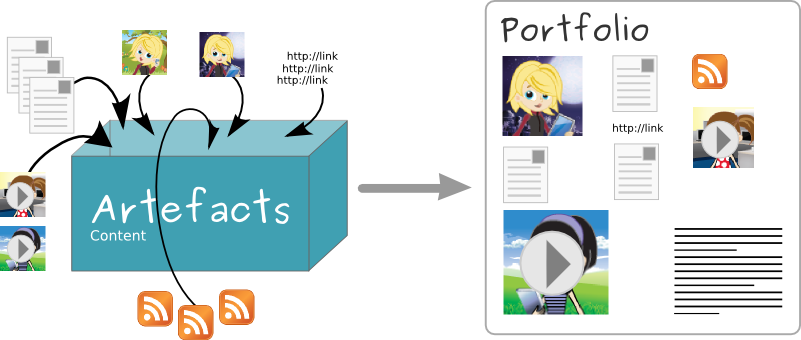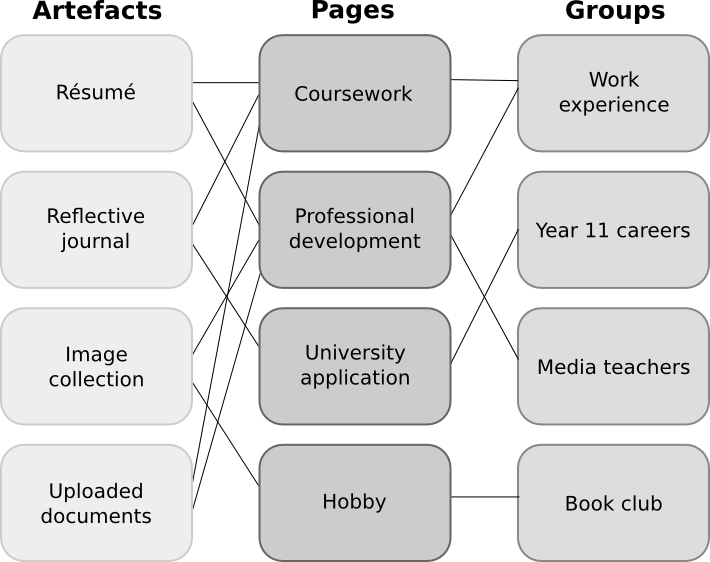1. イントロダクション¶
Welcome to the Mahara user manual. This user manual is designed to provide documentation for people who use Mahara on a day-to-day basis. It covers the functionalities of Mahara to provide you with information about what you see on the screen.
難しい話は抜きにして始めてみましょう!
1.1. Maharaとは?¶
If you’re wondering what Mahara or an ePortfolio is, why you might want one and what it can do for you, then read on – you’re about to find out.
At the simplest level, Mahara is two things: an ePortfolio and a social networking system combined. An ePortfolio is a system in which students can record 「evidence of lifelong learning」 – such as essays, artwork or other such things they produce that can be stored digitally. Such things are known as artefacts in Mahara. Social networking systems need little introduction – think Bebo, Facebook or MySpace. Basically, they give a way for people to interact with their friends and create their own online communities.
しかし、Maharaにはファイルの保存場所である以外に多くのものがあります。Maharaにはブログおよびレジュメビルダが実装されています。そして、Moodle <http://moodle.org/>`と統合することもできます。
1.2. Maharaフレームワーク¶
With Mahara, you control which items and what information within your portfolio other users see. Such items and information are termed artefacts. To facilitate this access control, all artefacts you wish to show to other users need to be arranged into one area. In Mahara this compilation of selected artefacts is called a 『page』. You can have as many pages as you like, each with a different number of artefacts, intended purpose and audience. Your audience, or the people you wish to give access to your page, can be added as individuals or as a member of a group. It can even be made publicly available.
例えばあなたは次を作成することができます:
- あなたの友人および家族を含む休日の写真および個人日誌のページ
- あなたのチューターの評価およびあなたの内省的学習日誌を含むページ
- a page to showcase your best pieces of work and your résumé for potential employers
- …
A single page or a collection of pages can make up your portfolio. Unless artefacts are placed in a page, they are not visible to anybody but you. You can use files that you uploaded or journal entries you wrote in as many pages as you wish. You only need one copy of your artefact.
Imagine you collected all your artefacts in a shoe box. Whenever you have a new artefact, you add it to the shoe box. When you are ready to create your portfolio, you take a look at the artefacts in your shoe box and choose those that you want to make available on a portfolio page. You can arrange the artefacts on that page to your liking.
The diagram below of example artefacts, pages and groups illustrates how content in Mahara can be shared and reused in different contexts and for different audiences.
1.3. Maharaはどのようにeラーニングランドスケープに適応できますか?¶
If you think of LMSs such as Moodle, Sakai and Blackboard as the formal, structured side of e-learning, then Mahara is the social, reflective side. An LMS and an ePortfolio complement one another in an online learning environment.
In particular, while Mahara’s APIs are open to all, Mahara can integrate with Moodle natively to provide a streamlined user experience. Since Moodle 2.0 this is not only limited to SSO via MNet, but students are able to export assignments, blogs and much more straight into Mahara to use as artefacts – which can then, of course, be placed into pages.
1.4. 私に必要な機能をMaharaがサポートしていない場合は?¶
Mahara has been designed from the ground up to be an open, pluggable system. Creating new artefacts, authenticating against a custom system and much more can be implemented simply through writing a plugin that uses the appropriate core API. What this means is that it is free and easy for you to customise almost anything about Mahara to suit your needs – and paid support is available through a network of Mahara Partners should you require it.
1.5. 他にやること¶
あなたはMaharaに関して基本概念を知ることができました。あなたは次のことができます:
- Maharaに実装されている機能一覧を閲覧します。
- あなたが試すため`デモを探索 <http://demo.mahara.org/>`してみるか、`Mahara <https://launchpad.net/mahara/>`をダウンロードしてください。
- Sign up to the mahara.org community and begin asking questions and contributing in the forums.
- このユーザガイドを続けて読みます。
1.6. Maharaを使うためのアイデアはどこで入手することができますか?¶
Mahara 1.4 Cookbook <http://www.packtpub.com/mahara-1-4-cookbook-for-training-education/book> (Ellen Marie Murphy著) が2011年9月に出版されました。Maharaを異なる設定で使用するための50以上のアイデアが説明されています。この本はPDFおよび印刷フォーマットで購入することができます。
The Mahara E-Portfolios: Beginner’s Guide by Derrin Kent and Richard Hand is the updated edition of the Mahara 1.2 E-Portfolios: Beginner’s Guide and a great reference for step-by-step instructions on how to create a portfolio and perform other tasks.
You may also wish to check what other books or papers have been published on Mahara or what users talk about in conference presentations.
1.7. ヘルプを取得する¶
- Contextual help is available throughout Mahara. Watch out for the Help icon
 . Click on it to find out more about the action you are about to perform.
. Click on it to find out more about the action you are about to perform. - あなたは`フォーラム <https://mahara.org/interaction/forum/index.php?group=1>`で質問することもできます。
1.8. Maharaおよびアクセシビリティ¶
Mahara aims to be usable by as many individuals as possible, including those with disabilities or special needs. Creating accessible web content is a requirement in many countries. In order to provide international guidelines, the Web Content Accessibility Guidelines (WCAG) were created. There are three conformance levels under the WCAG 2.0, the latest edition of the guidelines: A, AA, and AAA. Each level requires conformance with previous levels and includes its own specific guidelines for how websites should be made accessible.
With version 1.9, Mahara has reached level AA for user-facing areas of the system. The administration of Mahara is predominantly on level AA as well. Only a few things need to be corrected.
あなたがアクセシビリティの問題に遭遇した場合、 `私たちのバグトラッカに「accessibility」とタグ付けして報告<https://bugs.launchpad.net/mahara/+filebug>`してください。
If you are a screen reader user, you can use the following access keys to navigate the main menu items in Mahara:
標準ユーザインターフェース:
- d:ダッシュボード
- c: コンテンツ
- p: ポートフォリオ
- g: グループ
- a: 管理
管理者インターフェース:
- a: 管理ホーム
- c: サイト設定
- u: ユーザ
- g: グループ
- i: インスティテューション
- e: 拡張子
- h: サイトに戻る

